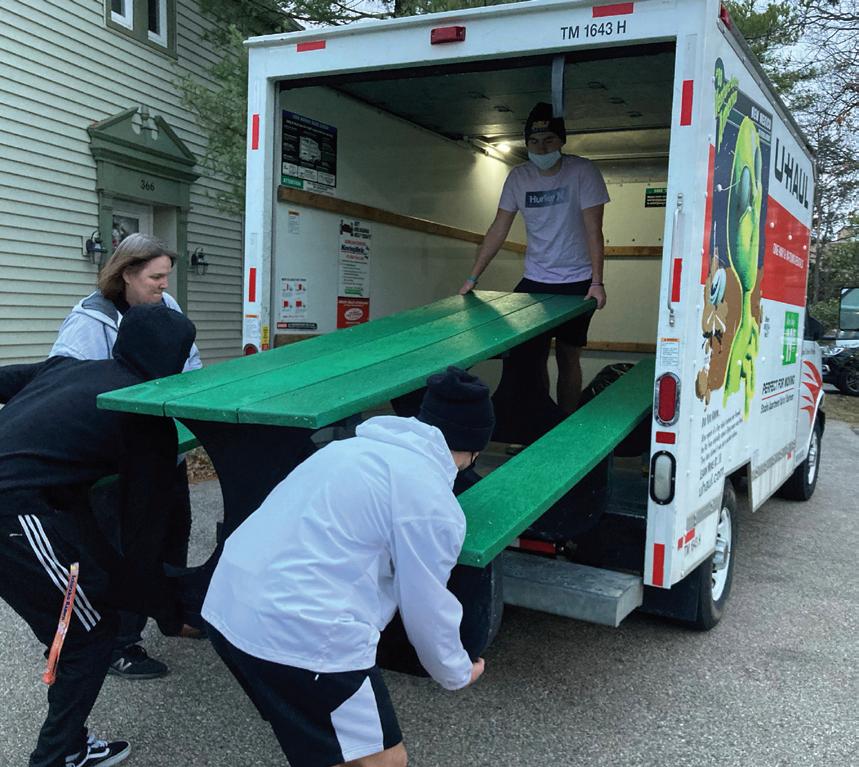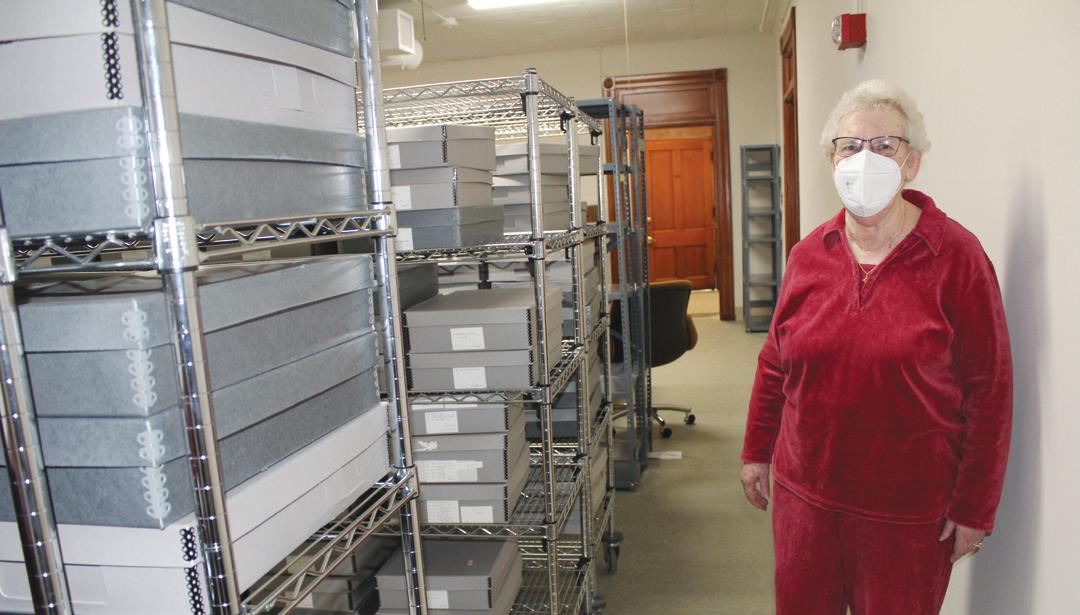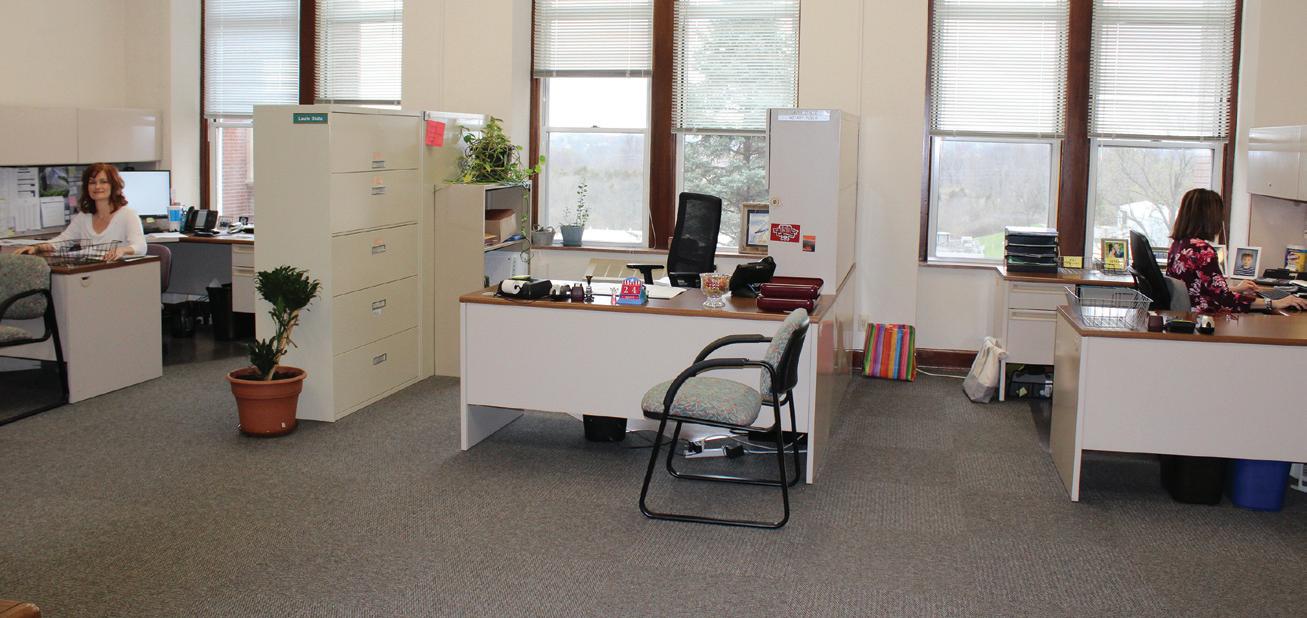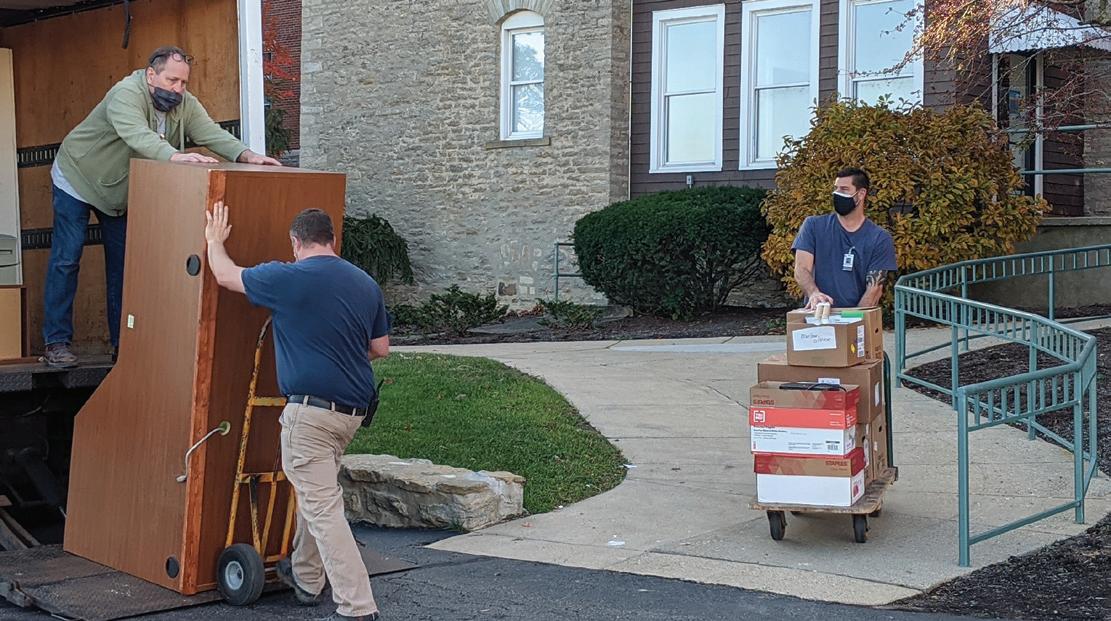
9 minute read
DeParTMenTS
Benches made out of recycled plastic bottle caps and lids sit at the entrance of EarthConnection. Serving Learning students from Mount St. Joseph University have been helping EarthConnection staff with research projects as well as working in the garden and on the bottle cap project.

Advertisement
Working Towards a Sustainable Future
By S. Caroljean Willie
There is a growing awareness that a moral voice is needed in the effort to work towards avoiding the worst impacts of climate change as well as to collaborate on sustainability initiatives for the benefit of all Creation. EarthConnection (EC) has taken an active role in this endeavor.
Several months ago, a new book was published entitled Faith for Earth: A Call for Action. It was coauthored by the United nations Environment Programme and the World Parliament of Religions. It describes the essential, unshakeable reverence that all religions have for creation and nature, and introduces the world’s major life support systems. The authors hope that the book will provide information and inspiration to learn more about Planet Earth and to encourage people to share knowledge and commitment to care for it, and to become part of the flourishing global interfaith movement that is increasingly bringing people together to protect and sustain life on Earth. EC hosted a webinar on this document. (Free download of book at www.wedocs.unep.org)
Shortly after that another publication was released by the United States Conference of Catholic Bishops, the Catholic Association of Diocesan Ecumenical and Interreligious officers, and the Catholic Climate Covenant entitled “Ecumenical and Interreligious Guidebook: Care for our Common Home,” as a guide to offer insights into how Catholics can bring the riches of the Catholic theological tradition to ecumenical and interreligious discussion and actions that uphold the dignity and sanctity of the environment. (Free download of book at https://www.usccb. org/resources/care-our-common-home).
At the local level, Green Umbrella, the Cincinnati regional sustainability alliance, initiated an Impact Team entitled Faith Communities Go Green whose mission is to partner with religious communities to create a more sustainable and equitable future for all by mobilizing their moral voice to reduce the risk of catastrophic climate change. S. Caroljean (Cj) Willie serves on the steering committee of this Impact Team and is working with people of multiple faiths throughout the Greater Cincinnati Area to bring the moral voices of our faith traditions together and to provide a platform for providing tools to congregations to use at their local levels, but also to share resources and work together to have a greater impact on environmental sustainability in our area. Post-pandemic, EarthConnection will be hosting a number of meetings and trainings on our site to work towards that goal. (www.greenumbrella.org/faith)
Plastic bottle caps and lids continue to pour in from all over the country to be recycled into benches and picnic tables. S. Winnie Brubach and Associate Sue DiTullio recently made another trip to Green Tree Plastics in Evansville, Indiana, and returned with a new picnic table and another bench.
EC is working with Mount St. Joseph University to provide service-learning opportunities for students. Several students are working on research projects while others are helping with the garden and the bottle cap project.
Due to the pandemic, we were not able to host meetings on-site, but have held webinars bi-monthly to continue to provide input on environmental issues. Speakers have included Fr. Terry Moran; S. Carol DeAngelo, SC (nY); S. Gertie Jocksch, SC (Halifax); S. Maureen Wild, SC (Halifax); Sue DiTullio, SC Associate; and S. Cj Willie. our website, www.scearthconnection.org, has previous webinars as well as information on upcoming ones. All webinars are free, but it is necessary to register on the website to get the Zoom information.
God’s Creation on the Move
By S. Teresa Dutcher
British historian Arnold J. Toynbee once wrote, “History is a vision of God’s creation on the move.” our Sisters of Charity Archives is certainly an example of this literally and figuratively in these past months.
As members of ACWR (Archivists for Congregations of Women Religious), we know that religious Archives are unique, containing not only the history of a congregation but also the history of the times in which Sisters serve. In 1852 the Sisters of Charity of Cincinnati became a separate congregation from the Sisters of Charity of Emmitsburg, Maryland, where Elizabeth Seton founded the first community of women religious native to the United States. In 150-plus years, we have collected a lot of archival material.
Today, many congregations, facing significant moves and closures, are deciding what to do with Archives’ collections. It is a normal process of creation moving into the future. our Congregational decision to demolish Seton Hall, the building in which we have housed our Archives along with other Congregational services, has sped things along. Downsizing while preserving the past for the future became the challenge. old media such as microfiche was digitized. Extra copies of Community-related books were sent to our sponsored ministries and other area heritage institutions. our Catholic Directory collection completed the collection of our sponsored ministry Mount St. Joseph University. Extras were advertised in the Catholic Research Resource Alliance newsletter for interested parties to complete their respective collections.
When addressing the need to downsize the extensive artifact collection in preparation for the transition to a smaller Repository space, Archivist Veronica Buchanan and S. Joyce Brehm worked to identify artifacts that personified a significant event, person or place in the Community’s history. Those items were prioritized for continued preservation while others that didn’t have any notable documentations in our extensive artifact inventories were de-accessioned over the past year. For example, statues like the Sacred Heart, which had been a fixture on the second floor of Seton Hall, were donated to the our Lady of the Holy Spirit Center in norwood, ohio. To further maximize efficient use of our new Repository space, all framed pieces were also evaluated and more than 40 oversized photographs, art prints and significant documents were pulled from their respective frames and moved into cabinets designed to store blueprints and maps.
Moving to a new, renovated space in our Motherhouse necessitated precise measuring, labeling, etc. Creating detailed floor plans of the new spaces and finding exact places for furniture in advance certainly helped expedite the moving process. S. Sheila Gallagher assisted to create these plans and coordinated on-site to execute the vision. We chose to be both creator and executor on the big day. Moving carts were divided into alphabetic pods so they could be moved and placed together in order. The actual move really could have gone awry quickly if the moving team didn’t communicate well to one another.
It has been rewarding to see the dedication and enthusiasm of our Archivist Veronica Buchanan, the Archives staff and our Congregational historian S. Judith Metz in not only preserving our history but in making it readily available to our own Congregation and to others in a meaningful way.

S. Sheila Gallagher helps movers and staff as they begin to position archival items into their new, renovated space in the Motherhouse. S. Sheila was integral in helping prepare for the move, creating detailed floor plans and intricately measuring all spaces and items that would be moved into each space. Archivist Veronica Buchanan assists movers with transferring the Archives Repository items to their new location in Marian Hall.

Moving In
Employees working in Seton Hall began preparations to move from the building at the end of last year, with most employees relocating in December 2020. Renovations of existing buildings and office space on campus as well as construction of a new ministry building on Bender Road will provide comfortable and upgraded work areas for employees.


2.



4. 5.

6.

8.
6. 1. Finance Office employees moved to the second floor of Marian Hall in December. 2. Much care transpired to plan and create the modern and efficient new work spaces for SC employees that will meet their needs for decades to come. 3. Transportation was the first to relocate from Seton Hall with its new offices situated on the first floor of McGree Hall. 4. In order for Communications to move into its new home on the first floor of Marian Hall, walls had to be removed and constructed, in addition to painting and carpeting work. 7. 5. Information Systems programmer/analyst Dave Buller enjoys his new office space in Marian Hall. In anticipation of the move, IS was integral in working with an outside company to improve network and WiFi capability within the Motherhouse. 6. Human Resources, originally located in St. Mary’s on the Motherhouse campus, has now been relocated into renovated space on the second floor of Marian Hall. 7. SC employees assisted movers with relocating office items and furniture from Seton Hall to their new homes on campus.
Saying Goodbye to Seton Hall
Demolition on Seton Hall officially began on the Sisters of Charity Motherhouse campus on Feb. 23, 2021 with the ceremonial first swing taken by Sisters of Charity of Cincinnati President Pat Hayden. The activity set in motion the careful process of taking the 90-year-old building down. Throughout the subsequent weeks, Sisters and employees watched carefully as the building was officially razed in a month’s time. Additional photos as well as tributes to Seton Hall can be found in the Photo Gallery of the Sisters of Charity website (www.srcharitycinti.org).
Shortly after the first swing took place, O’Rourke began demolition near the former Seton Hall entrance.


the limestone-engraved sign above the entrance of Seton hall was removed and saved before the building’s demolition. S. pat hayden takes the ceremonial first swing to begin the building’s demolition.


Members of the Sisters of Charity Leadership Team, Campus Refurbishing Committee and Turner Construction prepare for the beginning of demolition on Seton Hall. Demolition progress could be seen quickly. Only a few days after the project began nearly one wing of the building had been torn down.


One full week after demolition began the entire front portion of the building had been torn down and work continued on the back wing of the building, portions most recently serving offices for SC Communications, Finance and Transportation. One section of the building (closest to Marian Hall) was taken down brick by brick.


Nearly three weeks into demolition and the building was mostly razed. A view of the back wing of the building from Marian Hall. Four weeks after the demolition began and all that remained was rubble. A view of the new look of the west end of the Motherhouse from the parking lot used by Seton Hall employees and guests.












